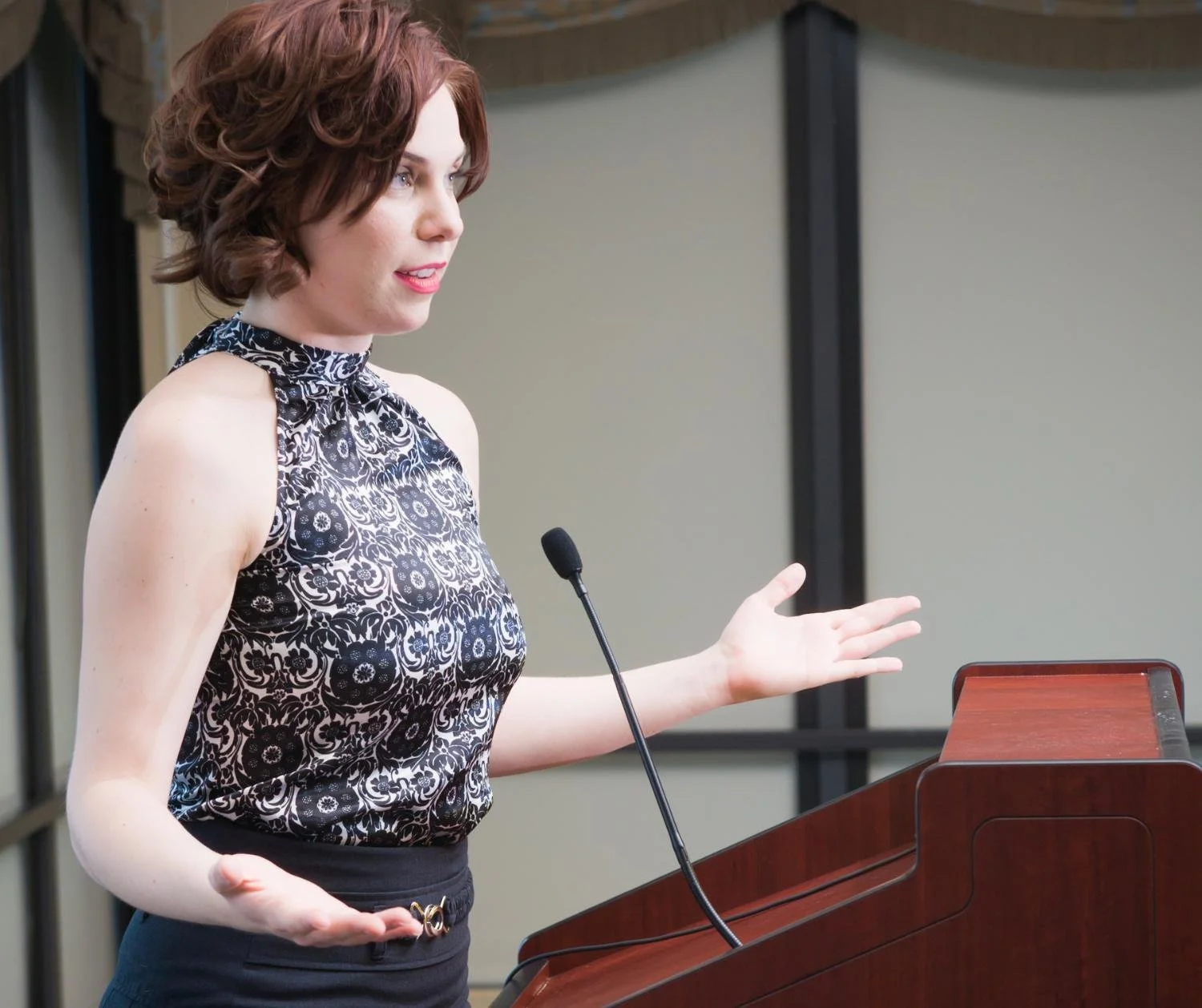Muscle Tension Dysphonia (MTD)
Detailed Explanation:
Muscle tension dysphonia is a voice disorder caused by excessive tension of the laryngeal and surrounding muscles during phonation, resulting in hoarseness, vocal strain, reduced range, or an effortful voice. It can be primary (without an underlying structural problem) or secondary to another condition. Treatment involves voice therapy to reduce muscular tension, optimize breath support, and restore efficient phonation; medical evaluation is performed if needed.
Examples of Muscle Tension Dysphonia (MTD):
A teacher develops a strained, tired voice after long days of lecturing and experiences vocal effort.
A professional uses throat clearing and tight voice quality after a cold and continues to feel tension long after recovery.
A client learns vocal relaxation techniques and breath support in therapy to reduce persistent strain.
Related Terms:
Vocal Warm-Ups
Breath Support
Frequently Asked Questions about Muscle Tension Dysphonia (MTD):
What causes MTD?
Causes include vocal overuse, poor vocal technique, stress, reflux, or compensatory behaviors following an illness or structural change.How is it diagnosed?
Speech-language pathologists evaluate voice quality and laryngeal function; ENT examination may rule out structural pathology.Is therapy effective?
Yes, voice therapy focusing on relaxation, posture, and breathing is effective for many individuals with MTD.Can MTD return after treatment?
Relapse can occur if habits return; ongoing vocal hygiene and practice of healthy techniques help prevent recurrence.When is medical intervention needed?
If there is suspicion of structural lesions, persistent hoarseness, or red-flag symptoms, referral to an ENT is appropriate.
Connected Speech Pathology Articles about Muscle Tension Dysphonia (MTD)
Psychogenic voice disorders can be deeply unsettling, especially when the voice stops working even though medical tests show no physical problem. Emotional stress, trauma, or overwhelming life experiences can interfere with normal voice use, creating real and disruptive symptoms. With compassionate treatment and gentle voice therapy, many people regain clarity, strength, and confidence in their natural voice.
Online singing voice lessons provide singers with a flexible and personalized way to strengthen their voices and refine their technique from the comfort of their own homes. With expert guidance, singers learn to expand their range, refine their tone, and protect their vocal health through evidence-based exercises and feedback. Whether you’re a beginner or a professional vocalist, online coaching provides the structure and support needed to build confidence and lasting vocal skills.
If your voice feels strained, hoarse, or fades by the end of the day, a voice therapist can help you find relief and restore your natural sound. These specialists use evidence-based exercises and techniques to improve breath support, vocal fold vibration, and overall voice quality. With consistent guidance and practice, voice therapy helps you speak and even sing with greater strength, clarity, and confidence.
Learning how to masculinize your voice is about more than simply lowering your pitch; it’s about developing resonance, breath control, and confidence in how your sound is perceived. With consistent, guided voice training, you can achieve a deeper, fuller tone that feels authentic and sustainable. With safe techniques and professional support, you can strengthen your voice without strain and express yourself with clarity and power.
Your tone of voice can completely change how people perceive your message. It’s not just about what you say, but how you say it; your pitch, pace, and emotion all shape understanding and connection. This guide explores how tone influences communication and offers practical ways to adjust your voice for clarity, confidence, and stronger relationships.
Vocal nodules can make speaking or singing feel exhausting, but with the right care, recovery is possible. Voice therapy helps reduce strain, restore clear sound, and build healthier habits that protect your vocal cords long term. With early treatment, many people regain their natural voice and avoid the need for surgery.
A strong speaking voice creates impact by shaping how your message is received and how confidently you are perceived. Many people struggle with weak volume, rushed delivery, or stage fright, which can cause their ideas to be overlooked. Voice training with a speaking voice coach helps build confidence, control, and presence, enabling your words to connect with every audience.
Pitch control transforms how you sound, whether you're speaking to a crowd, performing on stage, or recording for an audience. With the right mix of breath support, resonance, and vocal fold control, you can create a voice that feels natural yet powerful. Vocal coaching offers targeted exercises and expert feedback to help you refine your range, improve pitch accuracy, and deliver your message or performance with confidence.
Even if you’re not sick, frequent voice loss can be a sign that your vocal cords are under stress. Everyday habits like overuse, silent reflux, or tension in the throat can lead to hoarseness and fatigue that won’t go away on their own. With the right support, starting with a medical evaluation and voice therapy, you can restore your voice and protect it long-term.
Breath control is one of the most powerful tools a singer can develop. It supports vocal strength, improves pitch accuracy, and helps prevent strain during high or long notes. With the proper breathing techniques and consistent practice, singers of all levels can unlock a fuller, more confident voice.
Vocal nodules can make even simple conversations feel exhausting. For teachers, singers, and others who depend on their voice, that strain affects work, confidence, and connection. Online voice therapy offers real solutions from licensed experts—without ever leaving home.
Your voice is more than sound; it’s how you express yourself. Whether you’re struggling with pitch, recovering from strain, or managing a voice disorder, a singing voice specialist can help. Online sessions offer expert guidance that’s flexible, personal, and grounded in both performance and speech-language pathology.
If your voice feels tired, strained, or not as strong as it used to be, you’re not alone and don’t have to push through the discomfort. Professional voice training can help you build vocal strength, clarity, and confidence, whether speaking in meetings, teaching, or performing. With personalized support from a trained expert, you can protect your voice and communicate more effectively every day.
Your vocal tone shapes how people perceive you long before they focus on your words. Whether you're speaking in a meeting, delivering a presentation, or engaging in a casual conversation, the tone of your voice can either strengthen your message or undermine it. With practice, awareness, and support, you can develop a tone that feels natural, confident, and engaging in any setting.
A strong voice can shape how others see you and how you see yourself. Whether you're leading meetings, auditioning for voiceover roles, or simply trying to speak more clearly, voice coaching offers personalized support to help you sound confident and in control. With the proper guidance, your voice becomes a powerful tool for connection, expression, and presence.
A raspy voice can feel like your words are constantly catching, but it doesn’t have to be permanent. Your voice can regain its clarity and strength with the right combination of vocal rest, daily care, and expert support. Whether recovering from overuse or managing a long-term condition, there’s a path to clearer, more confident communication.
Online voice acting lessons offer a flexible and accessible way to train your voice for success, whether you're an aspiring performer or a professional looking to enhance your delivery. These courses cover essential skills such as vocal technique, script interpretation, and microphone proficiency, ensuring you develop both confidence and versatility. With expert guidance, structured training, and practical exercises, online learning makes it easier to break into the voice-over industry from the comfort of home.
Podcast voice training helps podcasters refine their vocal delivery, making their speech clearer, more engaging, and easier to understand. By focusing on clarity, expression, breath control, and pacing, podcasters can improve their ability to connect with their audience. With practice and the proper techniques, even common challenges like mumbling, monotone delivery, or vocal fatigue can be addressed to create a compelling listening experience.
If you’ve ever experienced hoarseness, vocal fatigue, or difficulty projecting your voice, you’re not alone. Your vocal cords work hard every day and need proper care to stay strong. There are effective ways to improve vocal health, from breathing exercises and resonance techniques to vocal warm-ups and hydration.
Muscle tension dysphonia (MTD) can feel overwhelming, but recovery is achievable with the right approach. Recovery time depends on factors such as the severity of the condition and consistency in treatment, but most individuals see improvement within weeks to months. Combining professional voice therapy with proactive home care strategies can restore your voice to a healthy, confident state.
Voice cracks in adults occur when vocal cords struggle to maintain stability, often due to strain, dehydration, or stress. This blog discusses the common causes and effective remedies to prevent and manage vocal instability. Discover practical tips and professional solutions to keep your voice strong and steady.
Increasing your vocal range opens doors to greater expressiveness and impact in both singing and speaking. With techniques like proper warm-ups, controlled breathing, and gradual practice, anyone can enhance their vocal flexibility safely and effectively. Seeking guidance from professionals ensures that your journey toward a broader range is supported by expert advice and tailored exercises.
If you're concerned about potential vocal cord damage, knowing what signs to look for and how to protect your voice can make a big difference. Hoarseness, vocal fatigue, and persistent throat discomfort are early indicators of possible vocal strain or injury. By understanding the causes and treatments for vocal issues, you can maintain a healthy, strong voice for work, hobbies, and everyday communication.
Voice disorders in children can hinder communication and social interaction, often causing frustration and concern for both kids and parents. Identifying signs like hoarseness, breathiness, or voice fatigue can lead to timely intervention and effective treatment. By addressing voice issues early, children gain confidence in their voice, improving their social skills and self-expression.
Early-onset Parkinson's disease (EOPD) significantly impacts speech, presenting unique challenges for those diagnosed before age 50. This condition can lead to hypokinetic dysarthria, characterized by a monotone voice, reduced volume, and imprecise articulation. Speech therapy, particularly methods like LSVT LOUD, can provide substantial benefits, helping individuals regain vocal strength and clarity, thereby improving their ability to engage in professional and social interactions.
Many people with neurological conditions experience difficulties speaking clearly. The Lee Silverman Voice Treatment (LSVT LOUD) offers a targeted solution to help individuals regain and improve their vocal strength, fostering stronger communication and connection. This guide explores the benefits of LSVT LOUD and how it can empower those with neurological conditions to communicate more effectively.
Maintaining vocal health is crucial for singers to ensure their voices remain strong, clear, and expressive. This guide explores the importance of vocal health, offering tips on hydration, vocal hygiene, and a healthy lifestyle to protect your singing voice. By following these strategies and seeking professional guidance for any issues, singers can enjoy a long and successful career with a healthy voice.
Getting a higher-pitched voice isn't just about hitting those desired notes – it's about embracing a sound that resonates with your identity and goals. Whether you're a singer seeking new musical territories or navigating gender affirmation, the journey toward a higher pitch is deeply personal. Through safe techniques like breath control and vocal placement, you can explore and expand your vocal range while prioritizing your voice's health and authenticity.
Crafting an androgynous voice is about breaking free from the confines of traditional gender norms, allowing individuals to express themselves authentically. This journey involves mastering spoken communication and singing to achieve a gender-neutral tone. Through vocal coaching and mindful practice, individuals can shape their voices to reflect their true selves.
Discovering the potential for a deeper voice presents an opportunity to exude confidence and authority across personal and professional domains. By comprehending the allure and biology behind vocal depth, individuals can initiate a journey toward enhancing their vocal resonance through safe and natural means.






























